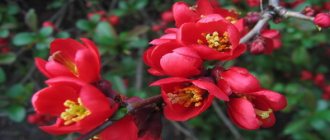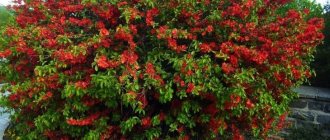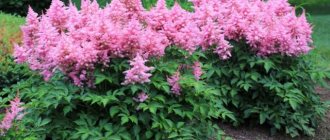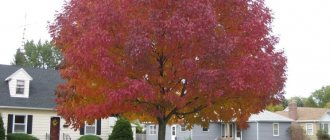In the article we will tell you what options exist for using Chaenomeles in decorating plots, local areas, and landscaping parks, with which plants a successful combination is obtained, as well as the best varieties for the landscape.
Chaenomeles - Japanese quince: varieties and varieties
Chaenomeles or Japanese quince is classified in the genus of the same name.
The natural habitat of quince is on the Japanese islands, China and Korea, where the plant lives on moist, humus-rich soils. Decorative quince is represented by deciduous or evergreen shrubs that grow up to 1 meter, or trees that reach 3 m.
Decorative quince
The branches of the plant are densely covered with beautiful shiny leaves of bright green color. The edge of the leaf blade is jagged, large stipules have a serrate shape. The branches of the plant are flexible, arched, and decoratively curved. Many species and varieties of Chaenomeles have sharp spines up to 2 cm long on their shoots. Sometimes there are no leaves on the branches, and the shoots are entirely covered with prickly spines.
The root system of the plant is taprooted, the roots are powerful and go deep into the ground. The plant is not afraid of drought: long roots are able to reach aquifers at significant depths. Transplanting an adult plant presents a rather serious problem - it is often impossible to replant a tree without damaging the root system.
The plant can boast of being particularly decorative during flowering. Take a look at the photo of a blooming Japanese quince: flowers with a diameter of 3-5 cm, sheer charm. The standard color of Chaenomeles flowers is red-orange, but there are varieties with pink and white colors. Individual flowers are collected in brushes with an even number of flowers (usually 2-6 pieces). The varieties with double flowers that completely cover the curved graceful branches look especially decorative.
Quince bush
This amazingly beautiful plant also bears fruit. At the beginning of autumn, small fruits ripen, densely covering the branches. The color of the fruit, depending on the variety, can be green, yellow or orange. The fruits remain on the branches until frost, which does not affect the quality of the fruit. Young plants begin to bear fruit from the 3rd year. The photo shows different types of Chaenomeles fruits, which resemble a quince or a small apple.
In the recent past, the plant was valued only for its decorative appearance. Modern breeding work is aimed at developing fruit varieties without thorns and thorns with improved fruit qualities and taste. The fact is that the fruits contain a record high percentage of vitamin C, which is preserved even when canned.
Japanese quince fruits
The variety of types of Japanese quince includes varieties:
- Chaenomeles Mauleya (low quince);
- Chaenomeles Cathayan;
- The quince is wonderful.
Application options with photos
The spectacular flowering of Chaenomeles invariably attracts everyone's attention, so they try to plant the shrub where it is under the best view - in front of the windows of residential buildings or next to a terrace or gazebo.
As a stand-alone decoration
Soloing in the center of a lawn of lush emerald grass, a Japanese quince bush, blazing with an orange-scarlet flame, attracts the eye, and the entire flowering period remains a bright accent of the landscape composition .
For single planting, tall varieties exceeding 1.5-2 m are suitable, for example, Gaillardi or Nivalis.
Hedge
Having a densely branched crown and thorns along the entire length of the shoots, Japanese quince forms wonderful hedges.
To arrange them, plants are planted in a row at a distance of 50 cm from one another. If a medium-high hedge is required, choose hybrid varieties that grow up to 1-1.5 m, for example:
- Diamond;
- Holland;
- Pink Lady.
Border plantings
For border plantings, it is advisable to opt for shrubs that do not reach a height of more than 0.8-1 m:
- Vesuvius;
- Nikolain;
- Fire Dance.
These same plants serve perfectly as a backdrop for mixborders located against the wall of a house or a high fence, and are also planted singly on alpine hills and in rocky gardens.
Rock gardens
is ideal for rock gardens and retaining walls . Its drooping branches gracefully wrap around stones or the top of a terrace ledge.
Vertical gardening
Japanese quince bushes grown for vertical gardening on a trellis near the wall of a building or on a special support are especially attractive.
Glossy foliage and flowers with snow-white petals look beautiful against a background of red brick and, conversely, blazing orange and dark red flowers look more expressive against white brick walls.
Flexible branches lend themselves well to shaping and can reach greater lengths than in conventional ground plantings.
Vaccination on a standard
Japanese chaenomeles, grafted onto a trunk, turns out incredibly charming. This method of cultivation can be done by experienced gardeners, but a ready-made standard purchased from specialized plant nurseries is usually easy to care for and does not require additional botanical knowledge.
Seedlings are used as rootstocks:
- rowan;
- hawthorn;
- common quince.
Standard plants are less resistant to frost in the middle zone.
Masonry culture
Chaenomeles japonica is also suitable for tub culture. The shrub is used for winter forcing in cool rooms , and with the arrival of warmth, containers with plants are taken out into the garden to create temporary compositions. Their location can be changed several times during the season, obtaining different options for landscaping the area.
Bonsai
Planting Japanese quince for cultivation using the bonsai technique is also successfully practiced. The plant overwinters indoors, and in the summer the dwarf shrub along with the pot is moved to the terrace to decorate the main entrances to the house. Dwarf varieties of Chaenomeles japonica are used; Rubra is the most common .
Proper planting of Japanese quince
Planting Japanese quince is best timed to coincide with the warm season; mid-spring is perfect for this purpose. Young seedlings can be planted in separate holes and trenches (planting hole depth - up to 40 cm, width - 50 x 50 cm).
To ensure that the plant actively blooms and bears fruit, plant it in a sunny area.
The plant is undemanding to soil, but cannot develop without regular dosed watering. Overwatering of the root system is also detrimental to a young tree, as is keeping it dry. Young Chaenomeles plants react negatively to feeding with organic fertilizers in the first three years of their life. Do not apply fertilizers during planting and during the further growth of the tree.
Advice! When planting Japanese quince, it is important to take into account the acidity of the soil - the plant does not tolerate salinity and hard calcareous soils.
If the depth of groundwater in the planting area is insignificant, it is necessary to provide reliable drainage and protect the roots of the young bush from getting wet.
Advice! It is very important not to bury the root collar of the plant when planting.
Quince tolerates partial shade, but this arrangement leads to reduced flowering and a low percentage of fruit production. When choosing a place to plant Japanese quince, it is necessary to provide maximum illumination of the crown. A young tree must be protected from direct wind. It is best to place quince plantings under the protection of buildings.
Care
Despite the fact that gardeners consider the Superba quince to be an unpretentious plant, it still needs care. Under proper conditions, the plant will delight with abundant flowering and a good harvest. The rules of care are limited to the following activities:
Watering .
This type of shrub has good resistance to drought and therefore does not require frequent watering. Despite this, young plants need water to gain strength for growth. For the first three years, quince should be watered in the summer and especially during severe droughts.- Trimming . It is carried out in early spring, when sap flow has not yet begun. It is necessary for the correct formation of the bush. No more than 12-15 shoots should be left on it.
- Pruning . Shrubs need to be pruned periodically, removing old, weak and dry branches. Branches that are more than 5 years old are considered old. Usually this procedure is carried out after winter, removing shoots broken by snow.
- Fertilizer . To get a large harvest, you can feed the plant. Both mineral and organic fertilizers are suitable for this. They can be applied twice a year, in the spring before flowering and after fruit formation.
Taking care of Superba quince is not difficult. As a result, you can get excellent results with dense flowering and a large harvest.
Chaenomeles - crop care, basic rules
Caring for the crop consists of formative pruning of the crown, which is carried out annually, as well as ensuring timely watering and weeding.
Sanitary pruning involves the annual removal of lower branches that lean toward the ground, as well as all old branches (over 5 years old).
Quince tolerates formative pruning well
In dry years, when watering quince, it is advisable to provide a layer of mulch so that the soil remains moist longer. The mulch layer can be laid in tree trunk circles in early spring, as soon as the snow melts.
In winter, the plant requires mandatory shelter from the cold. Therefore, before the onset of cold weather, it is useful to cover the branches and trunk of the Japanese quince with leaves and spruce branches. Sometimes adult plants have to be fenced with wooden shields in winter to protect them from the cold.
Advice! In winter, cover the tree with snow.
Features: Superior View
Magnificent quince prefers well-lit areas.
It has good drought resistance. Can grow for a long time without watering. Despite this, in the first years after planting the plant, it requires a sufficient amount of moisture.
This variety is considered quite winter-hardy . It can withstand cold weather. Despite this, it is better to cover young bushes for the winter.
Fertilizer and fertilizing for Japanese quince
Plants are fed intensively with liquid fertilizers from the 3rd year of life, when a strong root system has developed. In the spring, after the snow melts, the plant can be fertilized with nitrogen fertilizers, scattering them in tree trunk circles right on top of the soil cover. Spring rains and melting snow will gradually dissolve the fertilizer granules, which will slowly be absorbed by the soil.
In total, plants are fertilized 3 times per season; during the second and third fertilizing, mineral fertilizers are used.
No. 4. Sequence of work
In the land of the rising sun, when arranging a rock garden, craftsmen take into account many factors, including: size of the plot, color of the stones, features of the territory. For us, as people who do not profess Zen Buddhism, this task will be much easier. To make a rock garden with your own hands, you need to follow the following sequence of work:
- On the intended site, draw the shape of the future garden, drive pegs along the contour, and pull the rope. Remember that the shape should be as free as possible;
- level the area and remove a 10-15 cm thick layer of soil from it, using a bayonet shovel;
- the soil is cleared of weed roots. Moisten the soil and leave it for 7-10 days. During this time, undetected weeds may sprout. To guarantee, you can treat with herbicides;
- For better moisture removal, the soil is drained. It is necessary to dig up the area, add baking powder to the soil (you can take expanded clay, vermiculite, or even granite and brick chips). If the plants are planted in the soil, you can add a little fertilizer and peat;
- Geotextiles are placed on the bottom, which will suppress the growth of weeds, and a sand cushion (about 5 cm) is placed on top;
- then the selected pebbles or gravel are filled up to ground level, and in the places where the boulders will be located, depressions are made. Some people prefer to deepen the stones into the sand layer so that the composition is as stable as possible;
- we arrange the boulders according to a pre-designed pattern;
- pebbles for shrinkage can be spilled with water, you will need about 1 bucket for each m2;
- The final touch is creating waves with a rake. This is how we get an imitation of water;
- You can install a border along the edge of the stone garden. If the site is not completely horizontal, then it makes sense to install a low fence around the perimeter of the garden, which will prevent the pebbles from being washed away.
Methods of propagation of Chaenomeles
When propagating Japanese quince, you can use the seed method and vegetative propagation. Each method has its own specifics, positive and negative sides.
The seed method of propagation of Chaenomeles is used in breeding work to develop new varieties and for growing strong adapted rootstocks for garden and ornamental crops.
Quince seeds
Freshly harvested Japanese quince seeds can be sown directly into the ground (winter sowing). With this method, average seed germination is observed, but seedlings hardened in winter grow well. Spring sowing of plant seeds is also possible, but the seed requires stratification for 3 months at a temperature of about 0 C. Per 1 sq. m when sowing you will need about 5 grams of quince seeds.
When vegetative propagation of plants, it is allowed to use cuttings, layering, and root suckers.
the root shoots with part of the roots and plant them in a permanent place in fertile soil. The size of the hole for planting Chaenomeles offspring is adjusted depending on the size of the root system.
Another way of vegetative propagation of quince is to stimulate the emergence of seedlings from the lower branch of the tree. The selected strong tree branch is placed lengthwise in the furrow, covered with earth and left in this position until young shoots appear. Each bud of a buried branch produces vertical layers that quickly form a separate root system. Strong seedlings can be transplanted to a permanent place, weak ones can be grown throughout the year in greenhouses or greenhouses.
The vegetative propagation method is optimal for growing quince in a summer cottage
Excellent results were noted when cutting Chaenomeles . It is allowed to use annual green shoots and mature lignified branches for cuttings. Cuttings (length 15-20 cm) are cut from suitable branches of Japanese quince. Rooting is carried out in greenhouses or greenhouses in special cuttings.
Japanese quince reproduces well by grafting ; in this case, the rootstock can be plants of the Rosaceae family: pear, rowan, Japanese quince. Propagation by grafting is used to quickly produce a large number of plants.
Average prices for seedlings
Superba quince seedlings can be purchased at different prices, which depend on the growing region, nursery, age of the plant and the specific variety. For example :
- A seedling of the Elli Mossel variety can be bought for an average of 180 rubles.
- Jet Trail quince can be purchased for 790 rubles per seedling.
- Cameo nurseries offer an average of 641 rubles per seedling.
- Quince Nikolain is offered for 450 rubles.
These are approximate prices, but they can vary greatly depending on the region and the condition of the seedlings.
Diseases and pests of Chaenomeles
The plant is highly resistant to diseases, but the overall development of Japanese quince is negatively affected by winter frostbite of the trunk and branches, which opens the way for all kinds of infections.
Rust on quince
Very rarely the plant is attacked by aphids. Getting rid of the pest is not particularly difficult - trees affected by pests are treated with special preparations against aphids, and at the same time the garden is treated against the invasion of garden ants.
Sometimes flower gall midges attack quince.
Japanese quince in landscape design
Useful properties and contraindications
Northern lemon - as the fruits of Chaenomeles are often called - has a lot of useful qualities that are used both in medicine and in cosmetology .
Composition and presence of nutrients
Chaenomeles fruits contain rare substances (polyphenols, triterpenes and sterols) .
The first substance serves as an inhibitor of cancer cells, reduces the risk of developing cancer and significantly reduces the rate of development of already formed cancer cells.
The second and third substances serve as a remedy for streptococcal infections and help fight rheumatism and pharyngitis .
Medicinal properties
Regular use of Japanese quince fruits helps:
- overcome the problem of excess weight;
- reduces the risk of developing cancer;
- suppresses the activity of viruses and microbes;
- helps support immunity after illness;
- regulates the amount of bile;
- has a diuretic effect;
- helps relieve iron deficiency in the blood.
Use in cooking
Jams, jellies, preserves, compotes, and marmalade are prepared from the fruits of Japanese quince .
You can use the pulp of quince apples as a filling for pies.
Dried chaenomeles fruits are used to prepare compotes.
Use in cosmetology
Chaenomeles is widely used in cosmetology. A paste is prepared from the pulp of the fruit, which is used as a mask with an anti-inflammatory effect .
The juice helps eliminate dandruff, it is used as a facial tonic (tightens pores, regulates the activity of the sebaceous glands).
Read about other shrubs for the garden:
Viburnum Buldenezh - a shrub with snow-white balls of inflorescences
Privet is the best shrub for hedges and garden figures
White dogwood: 11 best garden varieties
Dangerous properties of Chaenomeles
There are a number of contraindications for the use of Chaenomeles fruits:
- Chronic constipation. Due to the tannins contained in the juice, the problem may worsen;
- Due to its high fiber content, Japanese quince should not be included in the diet of children under 3 years of age.
- Individual intolerance.
Japanese quince in landscape design
The graceful Japanese quince tree is appropriate in group plantings with ornamental shrubs, and also perfectly decorates parks when grown alone. The plant is decorative for a long period; almost the entire growing season, quince is decorated with flowers or ripening fruits. Landscape architects often use the plant for compositional plantings, given the plant's high decorative properties and resistance to adverse conditions.
Growing Japanese quince: video
Japanese quince: photo
Collection and storage of fruits
Harvesting Chaenomeles is very easy. The fruits ripen by mid-autumn , and the main thing is to have time to pick them before the onset of frost.
It is recommended to use a medical mask or respirator, since the fruits are covered with fluff, which can enter the upper respiratory tract and cause an allergic reaction.
Fruits should be stored in a cool, dark place with a humidity of about 80% . If you wrap the fruits in paper, their shelf life increases significantly.
Philosophy of the Japanese garden
We are used to gardens filled with plants and decorative elements. In the modern understanding, a garden is an area in which there is no place for emptiness, and the key point of a Japanese garden, on the contrary, is the abundance of free space and emptiness, which can cause a feeling of anxiety in a modern person, however, once you feel the atmosphere of a Japanese garden, the anxiety goes away, it is replaced by a pleasant peace.
The empty spaces “ma” emphasize the surrounding objects, or the elements of the garden emphasize the emptiness, define space - this is the personification of the well-known transitional forces of the two principles “yin” and “yang”. This principle, difficult to create a Japanese garden, is fundamental.
There are two more rather complex, but very important concepts in creating a garden - wabi and sabi, they are not easy to explain, they are part of the Japanese worldview, aesthetics and culture. "Wabi" is modesty and simplicity with inner strength, "sabi" is the personification of authenticity, antiquity and genuineness. The philosophical meaning of these concepts inherent in Japanese culture is the beauty of the imperfect, simple, natural, unfinished and devoid of excess.
In the Zen understanding of the world, the concepts of “wabi” and “sabi” represent a way beyond the material world, closer to simple, earthly life, where the outer shell of objects is not significant, what is inside, the deep essence, is much more important. The Japanese garden is designed so that a person can experience the beauty of the ordinary, the simple, without getting hung up on the appearance of the surrounding objects.
The system of Japanese garden art is based on the perfect and beautiful world of untouched earthly nature. Japanese gardeners do not change nature; they use what is at hand, emphasizing all the extraordinary beauty of the pristine.
Miniature model of the world
A Japanese garden is a natural, natural landscape presented in miniature. Once you enter this mysterious place, you will not see it completely. A distinctive feature of Japanese gardens is the competent division of the territory into sections (chambers), which are separate, completely new secluded corners with an individual view and decorative elements.
All the beauty of the garden, its secrets and mysteries can be seen only by entering it. Since the Japanese garden is hidden from prying eyes, there may be small holes in its fence, looking into which you will see only the smallest part of it.
Symbolism
The concept of a “Japanese garden” is a philosophy where each element of the garden plays not only a decorative role, it is also endowed with an individual meaning (symbol) that must be felt and understood; any detail of a Japanese garden must certainly take its place.
It is easier to understand the symbolism of each element if you are familiar with the culture and philosophy of Japan, but you can try to understand the symbols in a different way. Entering a Japanese-style garden, you are left alone with nature, immersed in the contemplation of the landscape and letting go of your thoughts, you can give free rein to your imagination, it will help you feel the atmosphere of the garden and understand the meaning of the compositions.











